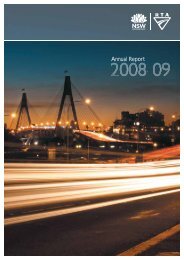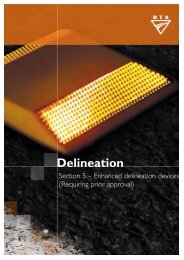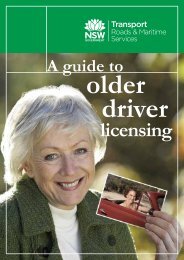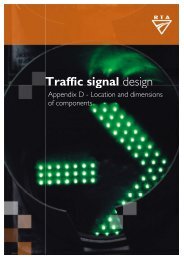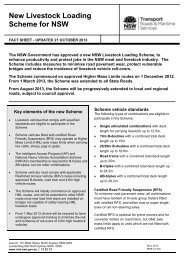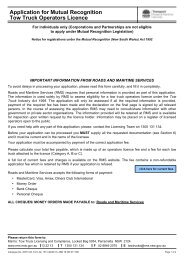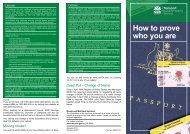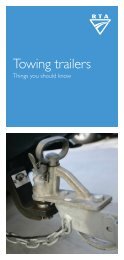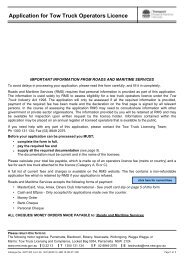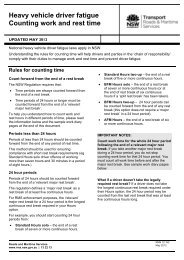Oversize loads of baled agricultural commodities - RTA - NSW ...
Oversize loads of baled agricultural commodities - RTA - NSW ...
Oversize loads of baled agricultural commodities - RTA - NSW ...
You also want an ePaper? Increase the reach of your titles
YUMPU automatically turns print PDFs into web optimized ePapers that Google loves.
<strong>Oversize</strong> <strong>loads</strong> <strong>of</strong> <strong>baled</strong><br />
<strong>agricultural</strong> <strong>commodities</strong><br />
FACT SHEET<br />
Transportation <strong>of</strong> <strong>baled</strong> hay and straw, wool and cotton.<br />
In <strong>NSW</strong> vehicles carrying <strong>loads</strong> <strong>of</strong> <strong>baled</strong> hay, straw, wool and cotton may exceed the statutory width limit <strong>of</strong> 2.5<br />
metres to a maximum <strong>of</strong> 2.7 metres. This initiative was introduced to facilitate the transportation <strong>of</strong> these <strong>loads</strong><br />
by allowing for some irregularity in the size <strong>of</strong> the bales, which tend to expand once loaded onto a vehicle and<br />
also during travel. The exemption was developed in close consultation with the Australian fodder, wool, cotton<br />
and farming industries.<br />
This fact sheet sets out the operating conditions for vehicles transporting these types <strong>of</strong> <strong>loads</strong> to help drivers<br />
and operators comply with requirements which are in place to ensure the safety <strong>of</strong> all road users. It is<br />
important to note that the exemptions only apply to the width and height <strong>of</strong> the load, and except where<br />
provided by the exemption, the vehicle must comply with all other requirements under road transport<br />
legislation.<br />
What type <strong>of</strong> <strong>loads</strong><br />
The Class 3 Baled Agricultural Commodities Load<br />
Exemption Notice 2012 applies to vehicles<br />
transporting <strong>baled</strong> wool, hay and straw. It also<br />
applies to rectangular bales <strong>of</strong> cotton that have<br />
been <strong>baled</strong> at a cotton gin. It does not apply to<br />
round cotton bales and modules.<br />
This Notice is available on the Roads and Maritime<br />
Services website.<br />
What type <strong>of</strong> vehicles<br />
The Notice only applies to vehicles with a gross<br />
vehicle mass or gross combination mass that<br />
exceeds 4.5 tonnes.<br />
Rigid vehicles, prime mover and semi-trailer and B-<br />
doubles combinations may have a load width up to<br />
2.7 metres.<br />
Truck and dog trailer, truck and pig trailer and road<br />
train combinations may have a load width up to 2.6<br />
metres<br />
AB and B-triples can also operate up to 2.6 metres<br />
wide, however the vehicles can only operate in<br />
<strong>NSW</strong> under a permit issued by Roads and Maritime<br />
Services.<br />
Current Permit holders will need to obtain an<br />
updated permit from Roads and Maritime Services<br />
in order to operate with a load width limit <strong>of</strong> 2.6<br />
metres.<br />
Maximum dimensions<br />
The constructed width <strong>of</strong> the vehicle must not<br />
exceed 2.5 metres.<br />
The load may exceed 4.3 metres, but not more<br />
than 4.6 metres in height. The maximum load width<br />
is 2.7 metres wide.<br />
The load on a truck and dog trailer, truck and pig,<br />
road train, B-triple or AB-triple must not exceed 2.6<br />
metres in width.<br />
The load on the vehicle must not project more than<br />
100mm from the outermost part <strong>of</strong> either side <strong>of</strong> the<br />
vehicle.<br />
The load on a vehicle or trailer must not be placed<br />
in a way that makes the vehicle unstable or unsafe.<br />
The load must be secured so that it is unlikely to<br />
fall or be dislodged from the vehicle, and an<br />
appropriate method to restrain the load to the<br />
vehicle must be used.<br />
The recommended performance standards are set<br />
out in Load Restraint Guide: Guidelines and<br />
Roads and Maritime Services <strong>of</strong> New South Wales<br />
This information is intended as a guide only and is subject to change at any time without notice. It does not replace<br />
relevant legislation.<br />
T 1300 364 847 then press 0 | E roadfreight@rms.nsw.gov.au<br />
www.rms.nsw.gov.au | 13 22 13<br />
June 2012<br />
RMS 12.163
performance standards for the safe carriage <strong>of</strong><br />
<strong>loads</strong> on road vehicles, Second Edition, as<br />
published by the National Transport Commission in<br />
April 2004.<br />
Travel conditions<br />
Vehicles with a load width up to 2.6 metres may<br />
continue to operate on the networks that they<br />
currently operate on.<br />
A vehicle with a load exceeding 4.3 metres, but not<br />
more than 4.6 metres in height must only operate<br />
on an approved 4.6 metre high route as set out in<br />
the current 4.6 metre High Vehicle Notice.<br />
A B-double exceeding 19 metres in length may only<br />
operate on an approved route as set out in the<br />
Class 2 B-double Notice 2010.<br />
A road train may only operate on an approved<br />
route as set out in the Class 2 Road Train Notice<br />
2010.<br />
B-triples or AB-triples may only operate on an<br />
approved route as set out in their respective permit.<br />
Truck and dog and truck and pig trailer<br />
combinations are only permitted to operate:<br />
• Outside the <strong>NSW</strong> Urban Zone; and<br />
• Only when travelling directly between the<br />
location where the <strong>agricultural</strong> commodity is<br />
produced and where it is stored, and any<br />
other location incidental to the production <strong>of</strong><br />
the <strong>agricultural</strong> commodity.<br />
Loads exceeding 2.6 metres<br />
in width<br />
A vehicle with a load that exceeds 2.6 metres up to<br />
2.7 metres in width may only be operated on the<br />
roads and areas that have been approved.<br />
Any applicable travel restriction that applies to a<br />
prescribed route, area or Limited Access Location<br />
must be observed.<br />
These approved areas and roads, travel restrictions<br />
and Limited Access Locations are set out in<br />
Appendix 1 <strong>of</strong> each Notice.<br />
Warning devices<br />
Vehicles with <strong>loads</strong> exceeding 2.6 metres must<br />
observe the warning device requirements <strong>of</strong> the<br />
Road Transport (Mass, Loading and Access)<br />
Regulation 2005 which is set out in full <strong>of</strong> Appendix<br />
2 <strong>of</strong> each Notice. These include:<br />
• A warning sign must be affixed to the front<br />
and the rear <strong>of</strong> the vehicle.<br />
• The warning sign must comply with the<br />
requirements set out in Part 7, Schedule 2<br />
<strong>of</strong> the Road Transport (Mass, Loading and<br />
Access) Regulation.<br />
• Delineators must be attached where the<br />
load projects on the side <strong>of</strong> the vehicle.<br />
• One delineator must be attached to the front<br />
<strong>of</strong> the lead trailer and another must be<br />
affixed to the rear <strong>of</strong> the last trailer on the<br />
side <strong>of</strong> the projection.<br />
• Where the load projects on both sides there<br />
must be at least four delineators – one on<br />
each side at the front <strong>of</strong> the lead trailer and<br />
one on each side <strong>of</strong> the rear most trailer.<br />
• When operating between sunset and<br />
sunrise a warning light must be attached to<br />
the top <strong>of</strong> the cabin <strong>of</strong> the vehicle or<br />
combination.<br />
• The warning light must only be switched on<br />
when the vehicle or combination is travelling<br />
or where the vehicle is in a stationary<br />
location that may cause danger to other<br />
road users.<br />
• The vehicle must have its low-beam<br />
headlights on while travelling in the daytime.<br />
• The vehicle must maintain a following<br />
distance <strong>of</strong> at least 200 metres from an<br />
oversized vehicle or a combination<br />
travelling in front, unless it is:<br />
o overtaking, or<br />
o travelling in a separate lane<br />
available for overtaking, or<br />
o travelling in an urban area where it<br />
is not reasonable or practicable to<br />
maintain a distance <strong>of</strong> 200 metres.<br />
Documents<br />
A copy <strong>of</strong> the Class 3 Baled Agricultural<br />
Commodities Load Exemption Notice 2012<br />
(excluding the appendicies) must be carried in<br />
the vehicle.<br />
Where a vehicle is operating under a permit, a<br />
copy <strong>of</strong> the permit must be carried in the<br />
vehicle. The notice or applicable permit must be<br />
produced upon a request made by an<br />
authorised <strong>of</strong>ficer or police <strong>of</strong>ficer.<br />
Failing to carry the relevant documentation is a<br />
breach <strong>of</strong> the exemption and fines will apply.<br />
In accordance with the Road Transport (Mass,<br />
Loading and Access) Regulations 2005, all<br />
Notices are published in the <strong>NSW</strong> Government<br />
Gazette.<br />
2



